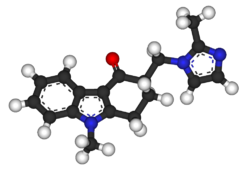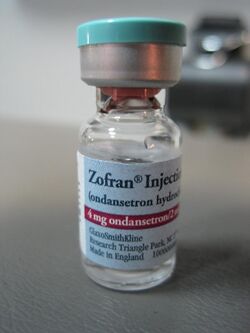Chemistry:Ondansetron
 | |
 | |
| Clinical data | |
|---|---|
| Trade names | Zofran, Atossa,[1][unreliable source?] others[2] |
| AHFS/Drugs.com | Monograph |
| MedlinePlus | a601209 |
| License data |
|
| Pregnancy category |
|
| Routes of administration | orally (by mouth), rectal, intravenous, intramuscular, thin film |
| ATC code | |
| Legal status | |
| Legal status | |
| Pharmacokinetic data | |
| Bioavailability | ~60% |
| Protein binding | 70–76% |
| Metabolism | Liver (CYP3A4, CYP1A2, CYP2D6) |
| Elimination half-life | 5.7 hours |
| Excretion | Kidney |
| Identifiers | |
| |
| CAS Number | |
| PubChem CID | |
| IUPHAR/BPS | |
| DrugBank | |
| ChemSpider | |
| UNII | |
| KEGG | |
| ChEMBL | |
| Chemical and physical data | |
| Formula | C18H19N3O |
| Molar mass | 293.370 g·mol−1 |
| 3D model (JSmol) | |
| |
| |
| (verify) | |
Ondansetron, sold under the brand name Zofran among others, is a medication used to prevent nausea and vomiting caused by cancer chemotherapy, radiation therapy, or surgery.[9] It is also effective for treating gastroenteritis.[10][11] It can be given orally (by mouth), intramuscularly (injection into a muscle), or intravenously (injection into a vein).[9]
Common side effects include diarrhea, constipation, headache, sleepiness, and itchiness.[9] Serious side effects include QT prolongation and severe allergic reaction.[9] It appears to be safe during pregnancy but has not been well studied in this group.[9] It is a serotonin 5-HT3 receptor antagonist.[9] It does not have any effect on dopamine receptors or muscarinic receptors.[12]
Ondansetron was patented in 1984 and approved for medical use in 1990.[13] It is on the World Health Organization's List of Essential Medicines.[14] It is available as a generic medication.[9] In 2020, it was the 83rd most commonly prescribed medication in the United States, with more than 8 million prescriptions.[15][16]
Medical uses
Ondansetron is indicated for the prevention of chemotherapy-induced nausea and vomiting and postoperative nausea and vomiting.[7][17]
Pregnancy
Ondansetron is used off-label to treat morning sickness and hyperemesis gravidarum of pregnancy. It is typically used after other antinausea drugs have failed.[18]
A large multi-center cohort study found no association between ondansetron exposure and fetal risk compared to other antiemetic drugs. [19]
Cyclic vomiting syndrome
Ondansetron is one of several antiemetic drugs used during the vomiting phase of cyclic vomiting syndrome.[20]
Gastroenteritis
Trials in emergency department settings support the use of ondansetron to reduce vomiting associated with gastroenteritis and dehydration.[21] A retrospective review found it was used commonly for this purpose, being administered in over 58% of cases. Its use reduced hospital admissions, but was also associated with higher rates of return visits to the emergency department. Furthermore, people who had initially received ondansetron were more likely to be admitted on the return visit than people who had not received the drug. However, this effect may simply be due to the agent being used more frequently in people who present with more severe illness. Its use was not found to mask serious diagnoses.[22]
Irritable bowel syndrome (IBS)
In a study of patients diagnosed as having IBS with diarrhea (IBS-D), ondansetron showed statistically significant effects on stool consistency, frequency, urgency and bloating, but not on pain scores.[23] This was confirmed in a later trial and meta-analysis[24] and is included in international guidelines.[25]
Special populations
Children
Ondansetron has rarely been studied in people under 4 years of age. As such, little data is available to guide dosage recommendations.[7]
Three open non-comparative studies have been conducted to assess the safety and efficacy of ondansetron in children receiving a variety of chemotherapy regimens.
Ondansetron was well tolerated and none of the patients experienced extrapyramidal symptoms.[26]
Adverse effects
Headache is the most common adverse effect.[7] A review of use for post-operative nausea and vomiting found that for every 36 people treated, one would experience headache, which could be severe.[27]
Constipation, diarrhea, and dizziness are other commonly reported side effects.[9] It is broken down by the hepatic cytochrome P450 system and it has little effect on the metabolism of other drugs broken down by this system. Anecdotally, ototoxicity has also been reported if injected too quickly.[9]
QT prolongation
Use of ondansetron has been associated with prolongation of the QT interval, which can lead to a potentially fatal heart rhythm known as torsades de pointes. Although this may happen in any person with any formulation, the risk is most salient with the injectable (intravenous) form of the drug and increases with dose. The risk is also higher in people taking other medicines that prolong the QT interval, as well as in people with congenital long QT syndrome, congestive heart failure, and/or bradyarrhythmias. As such, single doses of injectable ondansetron should not exceed 16 mg at one time. (Oral dosing recommendations remain intact, including the recommendation of a single 24 mg oral dose when indicated.) Electrolyte imbalances should be corrected before the use of injectable ondansetron. People are cautioned to seek immediate medical care if symptoms such as irregular heartbeat/palpitations, shortness of breath, dizziness, or fainting occur while taking ondansetron.[28]
Overdose
No specific treatment is available for ondansetron overdose; people are managed with supportive measures. An antidote to ondansetron is not known.[7]
Pharmacology
Pharmacodynamics
Ondansetron is a highly selective serotonin 5-HT3 receptor antagonist, with low affinity for dopamine receptors. The 5-HT3 receptors are present both peripherally on vagal nerve terminals and centrally in the chemoreceptor trigger zone of the area postrema in the medulla. Serotonin is released by the enterochromaffin cells of the small intestine in response to chemotherapeutic agents and may stimulate vagal afferents (via 5-HT3 receptors) to initiate the vomiting reflex. It is thought that ondansetron's antiemetic action is mediated mostly via antagonism of vagal afferents with a minor contribution from antagonism of central receptors.[29]
Pharmacokinetics
Ondansetron may have a degree of peripheral selectivity due to binding to P-glycoprotein and efflux out of the brain at the blood–brain barrier.[30][31][32]
History
Ondansetron (marketed under the brand name Zofran) was developed in the mid-1980s by GlaxoSmithKline in London. It was granted US patent protection in September 1987,[33] received a use patent June 1988,[34] and was approved by the US FDA in January 1991. It was granted another divisional patent in November 1996.[35] Finally, owing to GlaxoSmithKline's research on pediatric use, ondansetron's patent protection was extended until December 2006.[36] By this final year of its patent (2006), Zofran had become the 20th highest-selling brand-name drug in the United States, with sales of US$1.3 billion in the first 9 months of 2006 (80% from the US).[37] The first generic versions were approved by the US FDA in December 2006, with marketing approval granted to Teva Pharmaceuticals USA and SICOR Pharmaceuticals.[38] In 2018, University of São Paulo and Biolab were granted a patent for an orodispersible form of the drug.[39]
Society and culture
Publication bias
In 1997, ondansetron was the subject of a meta-analysis case study published in the British Medical Journal. Researchers examined 84 trials, with 11,980 people receiving ondansetron, published between 1991 and September 1996. Intravenous ondansetron 4 mg versus placebo was investigated in 16 reports and three further reports which had been duplicated a total of six times. The number needed to treat (NNT) to prevent vomiting within 24 hours was 9.5, with 95% confidence interval 6.9 to 15, in the 16 nonduplicated reports. In the three duplicated reports, the NNT was significantly lower at 3.9 (3.3 to 4.8). When all 25 reports were combined, the apparent NNT improved to 4.9 (4.4 to 5.6). Inclusion of duplicate reports led to a 23% overestimation of ondansetron's antiemetic efficacy.[40]
In addition, the authors found the covert duplication of reports on ondansetron was not easy to detect, because of lack of cross-referencing between papers, and reports containing duplicate findings were cited in eight reviews of the drug.[40] Their analysis was a subject of an editorial in the Journal of the American Medical Association in 1999.[41]
Availability
Ondansetron is a generic drug and is available in many countries under many brand names.[2]
References
- ↑ "Atossa". 2022. https://www.medicinesfaq.com/brand/atossa.
- ↑ 2.0 2.1 "Ondansetron international". 2 September 2020. https://www.drugs.com/international/ondansetron.html.
- ↑ "Ondansetron Use During Pregnancy". 3 October 2019. https://www.drugs.com/pregnancy/ondansetron.html.
- ↑ "Zofran Product and Consumer Medicine Information Licence". http://www.ebs.tga.gov.au/ebs/picmi/picmirepository.nsf/pdf?OpenAgent&id=CP-2013-PI-01055-1.
- ↑ "Zofran Product information". 25 April 2012. https://health-products.canada.ca/dpd-bdpp/info.do?lang=en&code=43116.
- ↑ "Zofran Tablets 4 mg - Summary of Product Characteristics (SmPC)". 19 January 2022. https://www.medicines.org.uk/emc/product/195/smpc.
- ↑ 7.0 7.1 7.2 7.3 7.4 "Zofran- ondansetron hydrochloride tablet, film coated". 24 June 2020. https://dailymed.nlm.nih.gov/dailymed/drugInfo.cfm?setid=555f81bc-4ce0-4f77-b394-b974838c4440.
- ↑ "List of nationally authorised medicinal products : Active substance: ondansetron :Procedure no.: PSUSA/00002217/202102". https://www.ema.europa.eu/documents/psusa/ondansetron-list-nationally-authorised-medicinal-products-psusa/00002217/202102_en.pdf.
- ↑ 9.0 9.1 9.2 9.3 9.4 9.5 9.6 9.7 9.8 "Ondansetron Hydrochloride". The American Society of Health-System Pharmacists. https://www.drugs.com/monograph/ondansetron-hydrochloride.html.
- ↑ "Ondansetron and probiotics in the management of pediatric acute gastroenteritis in developed countries". Current Opinion in Gastroenterology 31 (1): 1–6. January 2015. doi:10.1097/mog.0000000000000132. PMID 25333367.
- ↑ "Treatment of acute gastroenteritis in children: an overview of systematic reviews of interventions commonly used in developed countries". Evidence-Based Child Health 8 (4): 1123–37. July 2013. doi:10.1002/ebch.1932. PMID 23877938.
- ↑ Peterson's principles of oral and maxillofacial surgery. (3rd ed.). Shelton, CT: People's Medical Pub. House-USA. 2012. p. 86. ISBN 978-1-60795-111-7. https://books.google.com/books?id=Gxo8AwAAQBAJ&pg=PA86.
- ↑ Analogue-based Drug Discovery. John Wiley & Sons. 2006. p. 448. ISBN 9783527607495. https://books.google.com/books?id=FjKfqkaKkAAC&pg=PA448. Retrieved 25 August 2020.
- ↑ World Health Organization model list of essential medicines: 22nd list (2021). Geneva: World Health Organization. 2021. WHO/MHP/HPS/EML/2021.02.
- ↑ "The Top 300 of 2020". https://clincalc.com/DrugStats/Top300Drugs.aspx.
- ↑ "Ondansetron - Drug Usage Statistics". https://clincalc.com/DrugStats/Drugs/Ondansetron.
- ↑ "Ondansetron hydrochloride injection". 19 October 2022. https://dailymed.nlm.nih.gov/dailymed/drugInfo.cfm?setid=59c4227a-90b6-4297-aacd-05bd097010c1.
- ↑ "Treatment and outcome of nausea and vomiting of pregnancy". UpToDate. https://www.uptodate.com/contents/nausea-and-vomiting-of-pregnancy-treatment-and-outcome.
- ↑ "Comparison of Pregnancy Outcomes of Patients Treated With Ondansetron vs Alternative Antiemetic Medications in a Multinational, Population-Based Cohort". JAMA Netw Open 4 (4): e215329. April 2021. doi:10.1001/jamanetworkopen.2021.5329. PMID 33890993.
- ↑ "Cyclic vomiting syndrome in adults". Neurogastroenterology and Motility 20 (4): 269–84. April 2008. doi:10.1111/j.1365-2982.2008.01113.x. PMID 18371009. https://deepblue.lib.umich.edu/bitstream/2027.42/72300/1/j.1365-2982.2008.01113.x.pdf. Retrieved 4 November 2018.
- ↑ "Oral ondansetron for gastroenteritis in a pediatric emergency department". The New England Journal of Medicine 354 (16): 1698–705. April 2006. doi:10.1056/NEJMoa055119. PMID 16625009.
- ↑ "Ondansetron use in the pediatric emergency department and effects on hospitalization and return rates: are we masking alternative diagnoses?". Annals of Emergency Medicine 55 (5): 415–22. May 2010. doi:10.1016/j.annemergmed.2009.11.011. PMID 20031265.
- ↑ "A randomised trial of ondansetron for the treatment of irritable bowel syndrome with diarrhoea". Gut 63 (10): 1617–1625. October 2014. doi:10.1136/gutjnl-2013-305989. PMID 24334242.
- ↑ "Randomised, placebo-controlled trial and meta-analysis show benefit of ondansetron for irritable bowel syndrome with diarrhoea: The TRITON trial". Alimentary Pharmacology & Therapeutics 57 (11): 1258–1271. June 2023. doi:10.1111/apt.17426. PMID 36866724.
- ↑ "Functional bowel disorders with diarrhoea: Clinical guidelines of the United European Gastroenterology and European Society for Neurogastroenterology and Motility". United European Gastroenterology Journal 10 (6): 556–584. July 2022. doi:10.1002/ueg2.12259. PMID 35695704.
- ↑ Stevens, R F (1991-01-01). "The role of ondansetron in paediatric patients: a review of three studies". European Journal of Cancer 27 (Suppl 1): S20–2. ISSN 1879-0852. PMID 1831631. https://europepmc.org/article/med/1831631. Retrieved 8 July 2023.
- ↑ "Efficacy, dose-response, and safety of ondansetron in prevention of postoperative nausea and vomiting: a quantitative systematic review of randomized placebo-controlled trials". Anesthesiology 87 (6): 1277–89. December 1997. doi:10.1097/00000542-199712000-00004. PMID 9416710.
- ↑ US Food and Drug Administration. (2012). FDA Drug Safety Communication: New information regarding QT prolongation with ondansetron (Zofran). Retrieved from "FDA Drug Safety Communication: New information regarding QT prolongation with ondansetron (Zofran)". https://www.fda.gov/drugs/drug-safety-and-availability/fda-drug-safety-communication-new-information-regarding-qt-prolongation-ondansetron-zofran.
- ↑ "Role of central vagal 5-HT3 receptors in gastrointestinal physiology and pathophysiology". Frontiers in Neuroscience 9: 413. October 2015. doi:10.3389/fnins.2015.00413. PMID 26578870.
- ↑ "P-glycoprotein in the blood-brain barrier of mice influences the brain penetration and pharmacological activity of many drugs". Journal of Clinical Investigation 97 (11): 2517–24. June 1996. doi:10.1172/JCI118699. PMID 8647944.
- ↑ "Pharmacokinetic profile of the selective 5-HT3 receptor antagonist ondansetron in the rat: an original study and a minireview of the behavioural pharmacological literature in the rat". Canadian Journal of Physiology and Pharmacology 98 (7): 431–440. July 2020. doi:10.1139/cjpp-2019-0551. PMID 32017606.
- ↑ "The pronociceptive effect of ondansetron in the setting of P-glycoprotein inhibition". Anesthesia & Analgesia 103 (3): 742–6. September 2006. doi:10.1213/01.ane.0000228861.80314.22. PMID 16931690.
- ↑ Coates IH, Bell JA, Humber DC, Ewan GB, "1,2,3,9-tetrahydro-3-imidazol-1-ylmethyl-4H-carbazol-4-ones, composition containing them, and method of using them to treat neuronal 5HT function disturbances", US patent 4695578, issued 22 September 1987, assigned to Glaxo Group Limited
- ↑ Tyers MB, Coates IH, Humber DC, Ewan GB, Bell JA, "Method for treating nausea and vomiting", US patent 4753789, issued 28 June 1988, assigned to Glaxo Group Limited
- ↑ Tyers MB, Coates IH, Humber DC, Ewan GB, Bell JA, "Medicaments for the treatment of nausea and vomiting", US patent 5578628, issued 26 November 1996, assigned to Glaxo Group Limited
- ↑ "One Year Post-Pediatric Exclusivity Post-marketing Adverse Event Review: Drug Use Data Zofran". Memorandum. U.S. Food and Drug Administration. 7 March 2006. https://www.fda.gov/ohrms/dockets/ac/06/briefing/2006-4254b_06_03_OndansetronUseReview%20Cleared.pdf.
- ↑ IHS. (2006). Generics firms line up to enter Zofran market. Retrieved from "Generics Firms Line Up to Enter Zofran Market". https://ihsmarkit.com/country-industry-forecasting.html?id=106598562.
- ↑ "FDA Approves First Generic Ondansetron Tablets, Orally Disintegrating Tablets and Oral Solution" (Press release). U.S. Food and Drug Administration. 17 December 2006. Archived from the original on 18 June 2014.
- ↑ "Sabia que um remédio para enjoo traz 90% dos royalties que a USP recebe? - Agência USP de Inovação" (in pt-BR). http://www.inovacao.usp.br/sabia-que-um-remedio-para-enjoo-traz-90-dos-royalties-que-a-usp-recebe/.
- ↑ 40.0 40.1 "Impact of covert duplicate publication on meta-analysis: a case study". BMJ 315 (7109): 635–40. September 1997. doi:10.1136/bmj.315.7109.635. PMID 9310564.
- ↑ "Fair conduct and fair reporting of clinical trials". JAMA 282 (18): 1766–8. November 1999. doi:10.1001/jama.282.18.1766. PMID 10568651.
 |


